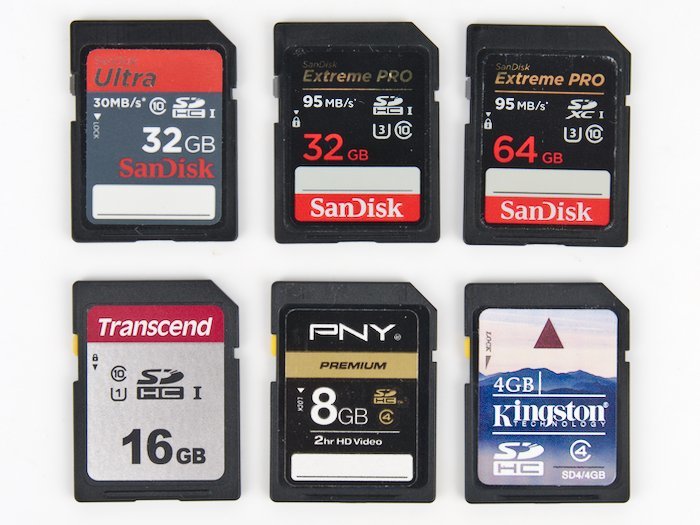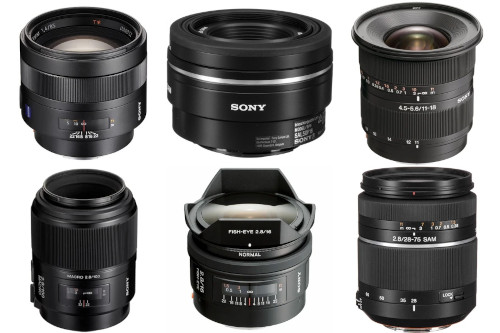
The 6 Best Lenses for the Sony A55
- Nathaniel Stephan
- Sony a55
- April 10, 2020
Table of Contents
The Sony A55 is a superb camera. If you don’t currently have a lens or are shopping for a new lens, this article will cover the top 6 lenses for the Sony SLT-A55.
Affiliate Advertising Disclosure
Outside the Shot is a participant in the Amazon Services LLC Associates Program, an affiliate advertising program designed to provide a means for sites to earn advertising fees by advertising and linking to Amazon.com.
As an eBay Partner, I may be compensated if you make a purchase. I also participate in affiliate advertising programs with KEH and Adorama. More can be found on the Affiliate Disclosure page.
Standard Primes
Sony 50mm f/1.8 SAM DT
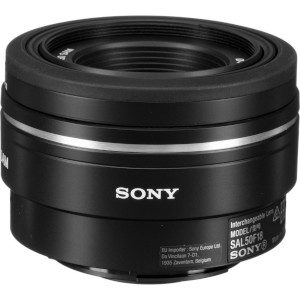
- Outstanding optics.
- Small and light weight.
- Can be difficult to find new.
- Smooth Autofocus Motor (SAM)
- Circular aperture.
See current price and more information on:
An awesome combination of lightweight and very small size. The autofocus motor is smoother and quieter than earlier lenses that use the physically coupled autofocus drive system.
Rounded aperture blades allow you to stop down to f/4 and keep an almost perfectly circular aperture. This results in beautiful bokeh and greater freedom in managing the depth of field.
Minolta Maxxum AF 50mm f/1.7
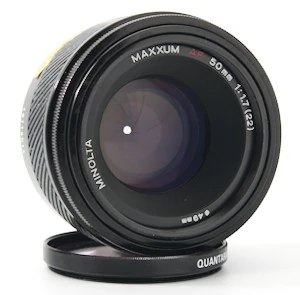
- Built-in lens hood.
- Amazing value.
- Light and compact.
- Widely available used.
- Coupled autofocus.
See current price and more information on:
This is among the first lenses from when Minolta originally unveiled the A-mount. Because of the age of the lens, the autofocus is controlled by a motor built into the A55 camera body.
Coupled autofocus can be sluggish and rather noisy. On the other hand, if that is not a problem for you the output is great. {The bokeh is pleasing and you will get a classic image rendering|You will end up getting a classic image rendering and attractive bokeh.
An additional significant benefit of this lens is the cost. It’s noticeably less expensive than the Sony 50mm f/1.8 and additionally might possibly be the cheapest lens on the list.
Sony 50mm f/1.4
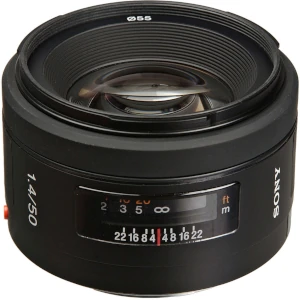
- Outstanding optics.
- Optical multi-coatings.
- Circular aperture.
- 55mm filter threads.
See current price and more information on:
A little faster compared to the Sony or Minolta f/1.8, however that can definitely be important when you’re taking pictures in low light. That undoubtedly comes at an additional expense.
It is still a light and small lens that fits nicely on the A55 and can fit into almost any kind of camera bag.
A slightly lower priced option is the Minolta AF 50mm f/1.4. Take into account that they can be very hard to track down in usable condition. It also uses coupled autofocus, which is worse than lenses featuring built-in motors}.
Portrait & Telephoto Lens
Sony 85mm f/1.4 ZA
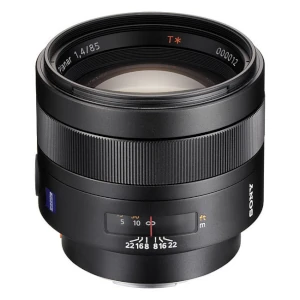
- Incredible bokeh.
- Excellent value used.
- T* coating to reduce flare and increase contrast.
- Astonishingly sharp wide open.
See current price and more information on:
Sony wanted to showcase what the A-mount is able to do. The lens was made by Zeiss. The ZA (Zeiss Alpha) shows that Zeiss designed the lens exclusively for the A-mount.
This is a great lens. Corner-to-corner sharpness with spectacular color that delivers stunning portraits.
A potential downside is that the lens is somewhat heavy thanks to being built like a tank and it can be slow to autofocus at times. Take into account, that you will find those same issues with any 85mm f/1.4.
Minolta Maxxum AF 85mm f/1.4
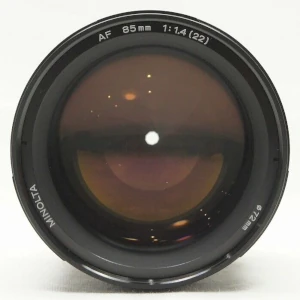
- Possible to find a good used deal.
- Superb image quality.
- Uses autofocus coupler.
- Double-Gauss design.
See current price and more information on:
In terms of cost, this lens is between the other 2. Finding a used copy in acceptable condition may be difficult due to a limited supply available.
The lens does have autofocus, but it uses a mechanical coupler and is driven by an in-camera body motor. This means that the lens will be relatively noisy and slow.
A Double-Gauss design is older and only contains six lens elements. That’s not a bad thing as the lens provides a distinctive look that is not able to be made with a contemporary lens.
Sony A55 Zoom Lenses
Sony 28-75mm f/2.8
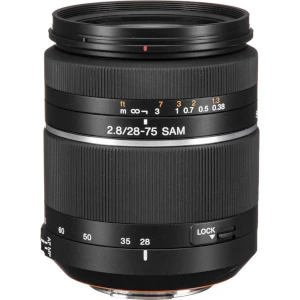
- Very usable zoom range.
- Great value used.
- Constant aperture.
- Smooth Autofocus Motor (SAM).
See current price and more information on:
If you want to shoot indoor shooting, night events, travel, and family photos, this is an ideal fast zoom for that. It is a well made lens with fairly quiet autofocus.
The lens is often compared to the legendary Zeiss 24-70mm lens, but it’s close to 1/2 the weight and has a lower price. Both create pro results.
Sony 55-200mm f/4-5.6 SAM DT
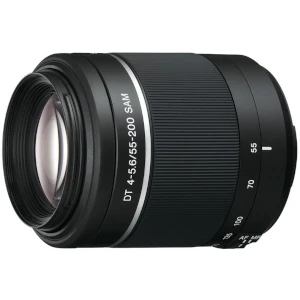
- Telephoto zoom range.
- Great for portrait or wildlife photography.
- Smooth Autofocus Motor (SAM).
- Inexpensive.
See current price and more information on:
While still delivering wonderful results, this is a lower cost selection. It is not a professional lens, accordingly as long as you do not expect all the bells and whistles, it is an excellent lens.
For a mid-range telephoto zoom, it has an excellent range for taking photos of wildlife, sports, and children outdoors.
The autofocus is fast and it produces sharp pictures. The outter body of the lens is made of plastic, which helps cut down on weight.
Sony 75-300mm f/4.5-5.6
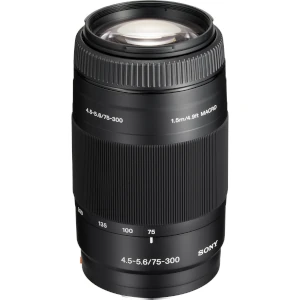
- Super telephoto zoom lens.
- Great for portrait or wildlife photography.
- 2.81 inches in diameter and 4.81 inches long.
- 55mm filter threads.
See current price and more information on:
This meets the criteria of a super-telephoto lens. It’s an excellent low-cost choice for when you want a long lens.
It is 4.8 inches (12.2 cm) long, 2.8 inches (7.1 cm) in diameter, and weighs in at 1 pound 2 ounces (510g). While that’s not light, many professional zooms are several times heavier than that.
For a little improved results you can look for the Sony 70-300mm f/4.5-5.6 SSM ED G-Series, but unfortunately count on spending just about twice as much.
Wide Angle Lens
Sony DT 11-18mm f/4.5-5.6
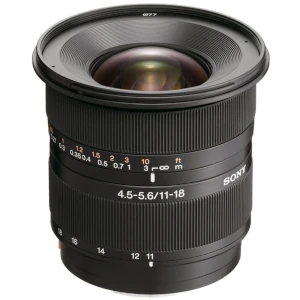
- Has a aspherical lens elements.
- Optical multi-coatings.
- Great value when purchased used.
- Circular aperture.
See current price and more information on:
Excellent value for the money if you want to be able to take beautiful wide pictures that standard kit zooms cannot get. Distortion, especially of straight vertical lines is minor or non-existent unless you are intentionally trying to get an distorted perspective.
Along with being ideal at capturing breathtaking landscapes, it’s a terrific lens to travel with. The lens is wide enough so when you come across something you’ll be able to get everything in frame.
Sony 20mm f/2.8
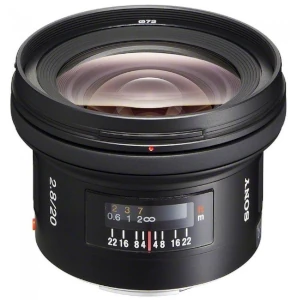
- Great for landscapes and architecture.
- Coated optics for clarity and definition.
- Rear focusing system for fast autofocus response.
- 72mm filter threads.
See current price and more information on:
It is a well-corrected lens that does a very good job of reducing lens distortion. In addition, a tremendous amount of effort has been done to decrease internal reflections and flare.
The result is a great lens that is well suited for landscape, architecture, and astrophotography. The lens has a rear focusing system which means the front will not rotate so you won’t have any issues using a polarizer or any other filter.
Tokina AT-X 11-16mm f/2.8 DX II
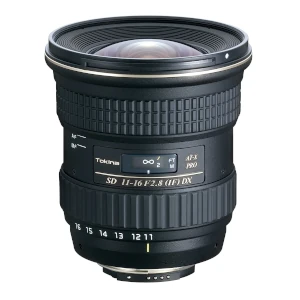
- Wide angle zoom lens.
- Hardened Alumite finish.
- Advanced optical coatings.
- All metallic moving parts.
- Designed for APS-C Sensors.
See current price and more information on:
It doesn’t have extremely fast autofocus, but the AF/MF focus clutch helps make it an excellent choice for manual focusing. A push or pull of the focus ring will switch the lens from auto to manual focus or vice versa.
The Tokina is faster when compared with the Sony 11-18mm, which isn’t a big deal for landscape or architecture photography. Where you’ll find a big difference is with astrophotography. That is a situation where you’ll want to have the 1-2 stop advantage the Tokina gives you.
Fisheye
Sony 16mm f/2.8 Fisheye
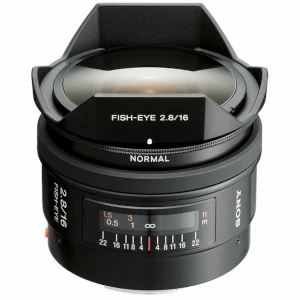
- Sharp corner-to-corner.
- 4 built-in filters: Normal, 056, B12, A12.
- 8 inch minimum focus distance.
- Aspherical and Extra-low Dispersion elements.
See current price and more information on:
Having built-in filters is an amazing inclusion because the lens has a fixed petal-style hood which prevents a lens filter from being put on the front of the lens.
- 056 - Accented contrast for black and white photos.
- B12 - Correct color by eliminating red tones.
- A12 - Correct color by eliminating blue tones.
This lens has just about everything you could require from a fisheye lens. You can get the exaggerated distortion, but the image will remain razor-sharp from corner-to-corner without vignetting.
Rokinon 8mm f/3.5 Fisheye
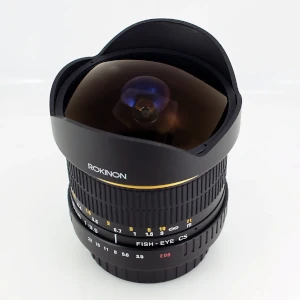
- Internal focus.
- 180 degree angle of view.
- Manual focus.
- Minimum focusing distance of 12 inches (0.3m).
- Designed for APS-C sensors.
See current price and more information on:
The lens has a rounded front which means filters cannot be attached. It comes with a snap-on petal-type hood that you’ll want to make sure is included if you get a pre-owned copy.
Build quality will be some what hit or miss on account of the very low price. Most buyers are really happy with the pictures they get. It is still important to carefully test the lens when you get it to know for sure that the lens isn’t substandard.
Macro Lens
Sony 100mm f/2.8 Macro
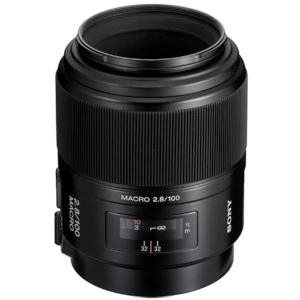
- 9 aperture blades.
- Focus range limiter.
- High contrast and resolution.
- 55mm filter threads.
See current price and more information on:
A great balance of cost, working distance, and weight for the Sony A55. The autofocus is a bit loud, but for taking macro pictures, manual focus is ideal.
For the highest quality results at 1x magnification the lens really needs to be stopped down. By stopping down you will get a larger depth of field, which is always important for macro photography.
Sony 50mm f/2.8 Macro
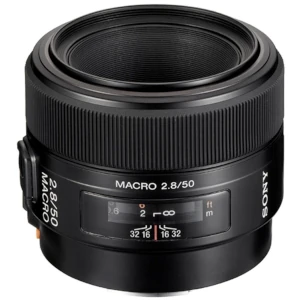
- 10.4 ounces (295g).
- Focus range limiter.
- Focus Hold button for full creative control.
- 55mm filter threads.
See current price and more information on:
A 50mm lens isn’t that good for 1:1 magnification as a result of how little working distance you’ll have. At 1:1 magnification, the front lens element will end up being around 2 inches (5 cm) away from the subject.
This lens excels at tabletop, copy work, and close-up photography. It enables you to get closer to a subject than a 50mm prime, and that is ideal for nature photography when you need to fill the camera frame with a small subject, like a flower.
Tamron AF 90mm f/2.8 Di SP A/M 1:1 Macro
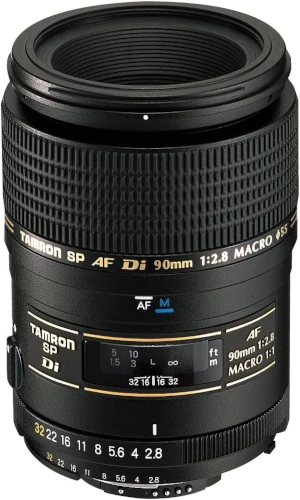
- Available in a variety of camera mounts.
- Improved resolution, chromatic correction, and optical coatings.
- Super Performance (SP)
- Focus clutch to switch between AF & MF.
See current price and more information on:
The focus ring feels great when manually focusing, and it also has autofocus. Closed down a couple of stops and you will get sharp images.
In additon, be cautious when getting it as it’s built in a number of camera mounts.
Used A-Mount Camera Lens Prices
Prices change on a regular basis. During the past handful of years, participation in film photography has been rising. As there are Minolta 35mm cameras that use A-mount lenses, some additional demand is added to the price of lenses.
The Sony A-mount also doesn’t have a large share of the market. As a result, a smaller number of third party options are available and the lenses built by Sony are quite often on backorder.
To get the cheapest price on what you want to buy, look at a few sites. For used lenses, be ready to make a purchase when you find a bargain as they will not last very long.
What Lens Mount Does the A55 Use?
The Sony A55 uses the Sony A-mount. It is also identical to the Minolta A-mount. This is because Sony acquired Konica Minolta’s imaging division in 2006.
The A-mount was created by Minolta for the intro of interchangeable lens cameras with autofocus in 1985. It is still Supported by Sony.
Standard Lens Cap Size
Generally 55mm, but in reality the sizes are all over the place. Earlier Minolta lenses have 49mm filter threads.
You can also find a good number of lenses that have much larger filter threads than 55mm. It isn’t rare to see 77mm ro 72mm. It would have been good if Sony tried to stick to only 2 or 3 different filter sizes.
